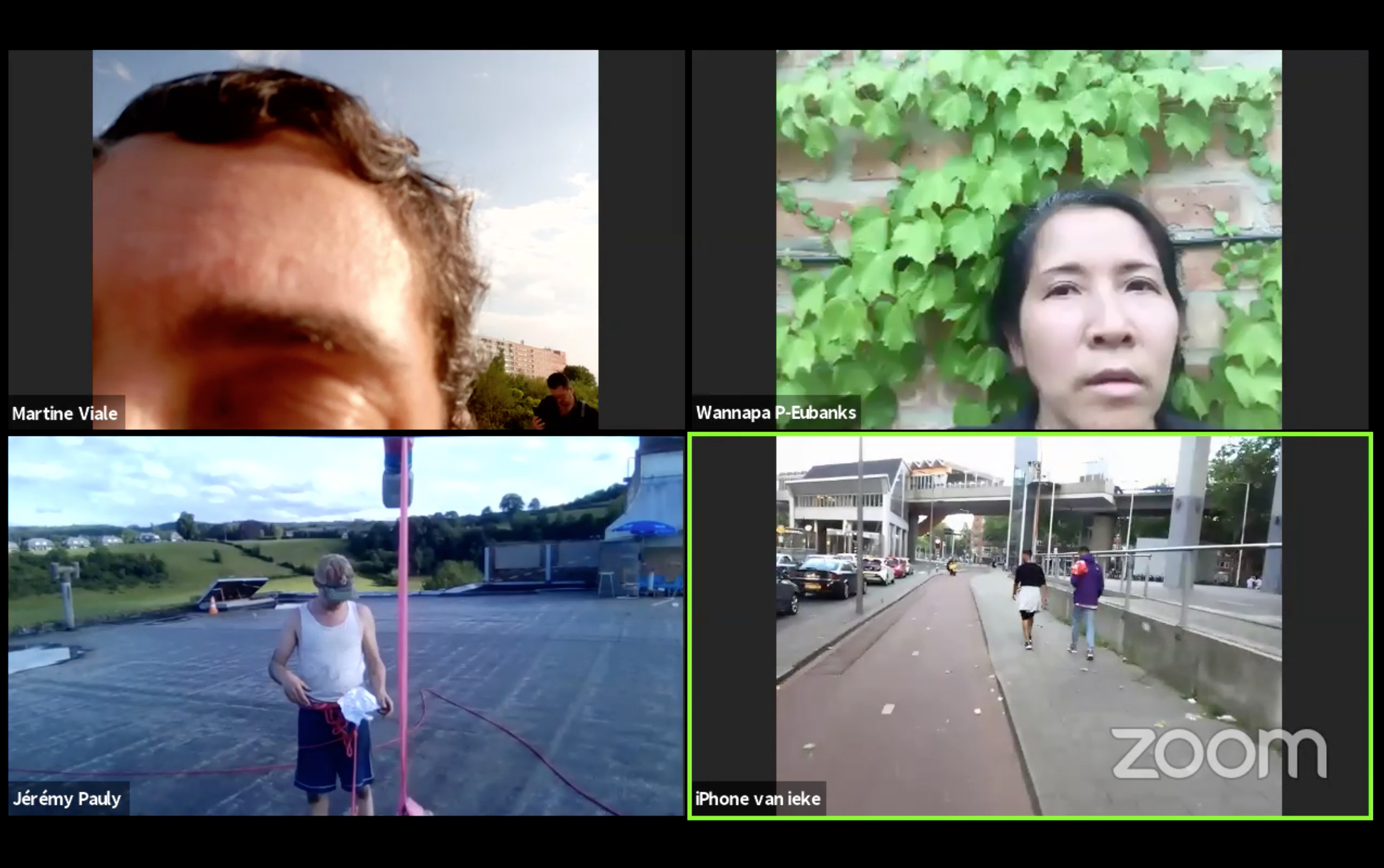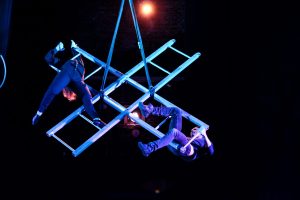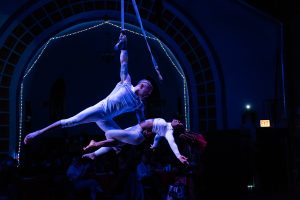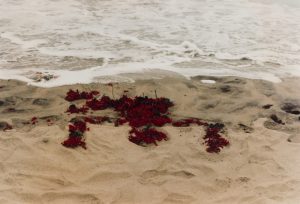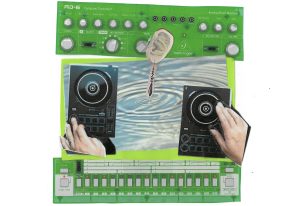Since its inception, Out of Site (OoS) has sought to create wonder through “unexpected encounters in public space.” Performances took place in unusual places, such as alleyways, parking lots, underneath the El tracks, as well as during the middle of Wicker Park Fest. However like many performance art groups and initiatives during the coronavirus shutdown, Out of Site pivoted to present innovative performance art through live streaming tools.
Started by Carron Little and Whitney Tassie in 2011, this public performance art series has brought artists from all around the world and on to the streets of Wicker Park, Noble Square, and other parts of the city. Performances varied in tone whether it was two women, Elena & Erin, pushing a cabinet down Milwaukee avenue or Austin-based artists performing an underwater puppet show with a truck-sized whale in Ballenarca.
Taking performance art into the digital realm seemed like a natural step. Out of Site teamed up with Experimental Sound Studio’s (ESS) The Quarantine Concert series on May 26th to present Out of Site Virtual Performance. Donations through ESS raised would support the performers. Carron Little, curator (and friend of the writer) explains that ESS “created a platform to support artists through a platform who had lost income” due to the virus. This matched well with OoS’s philosophy of supporting the artistic community through pay and performance development.
Little decided to reach out to alumni of OoS to see if artists would be interested in performing in a digital format. She was keen to have a combination of solo and collaborative performances for the May 26th event. In particular, she wanted to foster collaborations that may not happen easily in other situations; she was particularly keen to connect her former student, Michal Samama (Israel), with “internationally renowned performer” Martine Viale (France) since she saw a lot of confluences between their work. The two artists were open to the idea and hit it off at their first meeting.

Normally, Little has performers come together in her home to share their work and life stories as a way of fostering a sense of community. Due to the virus, Little used Zoom which has turned into a tool that is “an essential platform to build community.” The performers met virtually several times and even continue to gather even after the May performance. There was a lot of preparatory work to figure out the pieces themselves and Carron was able to develop work with the artists. She says, “My job as a curator overlaps with the role of director, facilitating people’s ideas and working out what they are trying to communicate so that all [of] the performances are the best they can be.”
But she also found herself in the important role of technical director, figuring out how to switch between artists during the live streaming show. Little notes that “There was a lot of digital troubleshooting.” For one of the artists, Wannapa P-Eubanks, it was the first time she’d ever live-streamed a performance so she was nervous. After the piece, she says, “I felt so light and enjoyed it. Now it’s less stress” and she’s looking forward to the new potential that it offers.
For the May 26th performance, six artists from Chicago and across the world teamed up to present their work with OoS at the Quarantine Concert. One of the most exciting parts of the evening was watching the performers playing with the very medium of live streaming. For instance, Samama and Viale’s piece played with the visual potential of Zoom; each artist mirrored each other as they created shapes and colors using Zoom filters and backgrounds. They managed to make the stream look like an animated film.

In Ieke Trinks (Netherlands)’s Face to Screen, Trinks wanted to respond to how we communicate via screens especially during the coronavirus. “Suddenly in my daily experience, I’m sitting a lot, communicating a lot in front of my laptop with other people. It’s a lot of face. Body is sorta excluded. If you meet people in real life, you see a full person,” Trinks says. In the work, Trinks presents her head and upper body on a table, gazing at the viewer, treating her body as if she was a puppeteer and her heads/hands/arms were her puppets. She worked to explore how to make expressions on her face, which she found really hard. Ultimately, Trinks says, “I can animate my face with my hands, then these things become actors, [the] face is on their own thing, my hands are their own things, have their own lives.” While she had hesitations about live streaming due to the lack of an immediate and felt audience, she believes “ [it] worked out really well. It was a pleasure to perform because I did feel the presence of others.”
In P-Eubanks’ work, she draws on her work as a butoh performer for “Reset.” In the work, she created a cacophony of noise and movement using everyday kitchen utensils while using her couch and living room as a backdrop. P-Eubanks wanted to explore the emotional toll that people are facing during the crisis. Right now she’s caring for two children who normally are in school. But she wanted to end on a positive note, how we need to “reset our bodies,” Carron adds. Ultimately, P-Eubanks says, “my hope is other people can connect and… feel that you are not alone.” In addition to Samama, Viale, Trinks, and P-Eubanks, other performers include Allen Conkle (San Francisco) and Jérémy Pauly & Jérome Pauly (Belgium), and Free Air: Amy Sinclair & Regin Igloria (Chicago).
Aside from some technical glitches, the OoS’ virtual performance sparked a lot of great discussion and dialogue, especially since it was streamed via Twitch. The streaming platform has predominantly been used by gamers so many people stumbled upon the performances without knowing much about it. In particular, Little says: “This gamer from Toronto was blown away by it.” She was pleased about this new audience since OoS strives to “Reach diverse audiences with our work. That is the primary objective of what we do to take artistic ideas and bring them to new audiences.”
However, Little noted that it was a challenge to keep up with the dialogue while also working on the technical aspects of the show but she managed to make it work.
As for Little and the performers, they were really pleased with the experience; the collaborations and the meetings helped the artists through this difficult time. Little says, “Some were feeling extremely isolated. The whole creative process of making these performances for this new medium, it really gave everybody a new sense of hope.” So much so that the artists want to do it again but want to have the next performance be less American-centric in terms of time.

Moreover, in the Zoom calls with artists since May, Little notes that the discussion has focused on how live streaming allows people to “See the reality of what is going on in the world yet because it is not filtered anymore, we experience the shock and the pain and trauma.” For Carron, she says “ There is an integral relationship between the performances and international experience we have been going through with the pandemic.”
On June 27th, Random Acts by OoS took place with two performances. The first was a simultaneous public performance piece between four artists— Ieke Trinks, Martine Viale, Jeremy Pauly & Wannapa P-Eubank— who co-wrote a score that they performed in public places in the US, Belgium, Netherlands, and France. Little wrote: “When performers work together over a period of time we can work in synchronicity and this is an important part of collaboration. The ability to respond fully to another person. In the hustle-bustle of the live stream world, I think we created a moment of connection to our bodies in public space that people could sense and reflect on. A person shared “lines of perception are in the mind” in response to the artists’ scores.”
Chicago based artists, Amy Sinclair and Moki Tantoco, known as Free Air, created a live piece based on participants’ responses to a survey. People were asked about their favorite color or a color that represents their mood and questions like, “What does hope look like to you?” They created an abstract painting on their lawn using shaving cream and other materials to represent our collective idea of hope.
“We first started thinking about connectedness and joy we felt we were missing in our daily lives. How could we bring joy and feel connected with our family, friends, and those who may seldomly or who often participate in performance art?” Amy Sinclair explains “We wanted to reserve a moment of time where we could be playful and practice hopefulness about the future.”
For the piece, Sinclair and Tantoco wanted to create “A painting without traditional means of painting. Beginning with the colors we wanted to use, we investigated means of creating those pigments with things we had on hand. We worked backward from those pigments, and sorted through several books of symbols and phrases—matching the colors with their meanings, according to the texts. Then, we created a Menti Meter to start the conversation with the audience—capturing their thoughts about what their ideal future looked like, what gave them hope about the future.”

After the second performance, the artists led small discussion groups about the pieces and the experience of Out of Site via live streaming.
OoS is also going to have another performance with ESS on July 24th co-curated by Martine Viale, ieke Trinks, Allen Conkle, Jeremy Pauly, Amy Sinclair and Wannapa P-Eubanks, the artists who participated in May. The scheduled performers are Vanessa Dion Fletcher (Canada) in collaboration with Mar Serinya (Spain), Va-Bene Elikem K. Fiatsi (Ghana), CV Peterson (Wisconsin), Sara Zalek (Chicago, US), and Sheila Toledo Ribes (Switzerland). On August 29, the original artists will give a talk as the final part of OoS.
While they are still figuring out who will be featured, Little hopes that the performance will also include workshops and other events around the ESS event.
Ultimately, the OoS is seeing new potential in this virtual realm. Little concludes: “The great thing about this medium [is that] it does foster opportunity for international dialogue and exchange [which is] so vital right as we are so isolated.”
Featured Image: The screen is split into four different views. The top left shows Martin Viale’s forehead and hair. She has short dark hair. Behind her, there’s a light blue sky with minimal clouds. There are a few pale pink buildings with some green trees in the background. There’s a man in a dark shirt who may be looking at his phone. The top right shows Wannapa P-Eubanks’ face; she has black hair and is wearing a black top. She is standing in front of a red brick building with bright green ivy. At the bottom left, Jérémy Pauly is standing on a blacktop, possibly a roof in a white sleeveless shirt and blue shorts. He appears to have a tangle of pink ribbon and a white bag tied to his waist. A pink ribbon is tied to what looks like a boom mike overhead and the pink ribbon hangs down in the middle of the screen. At the bottom right on Ieke Trinks’ screen, there’s a grey sidewalk and a pink grey bike path that leads to a train station overhead in grey and white. On the right, there are two figures walking away, one is wearing a black top with a white sweater tied to their waist. The other person is wearing blue jeans and a bright purple jacket with a yellow and red decoration on their left shoulder. To the left, there are a series of parked cars. Courtesy of Elisa Shoenberger.

Elisa Shoenberger is a freelance writer and journalist in Chicago. She has written for Boston Globe, Huffington Post, Artsy, Hyperallergic, Deadspin, and others. She writes regularly for Book Riot and Streeterville News. She plays alto saxophone in her spare time and occasionally stilt walks.
